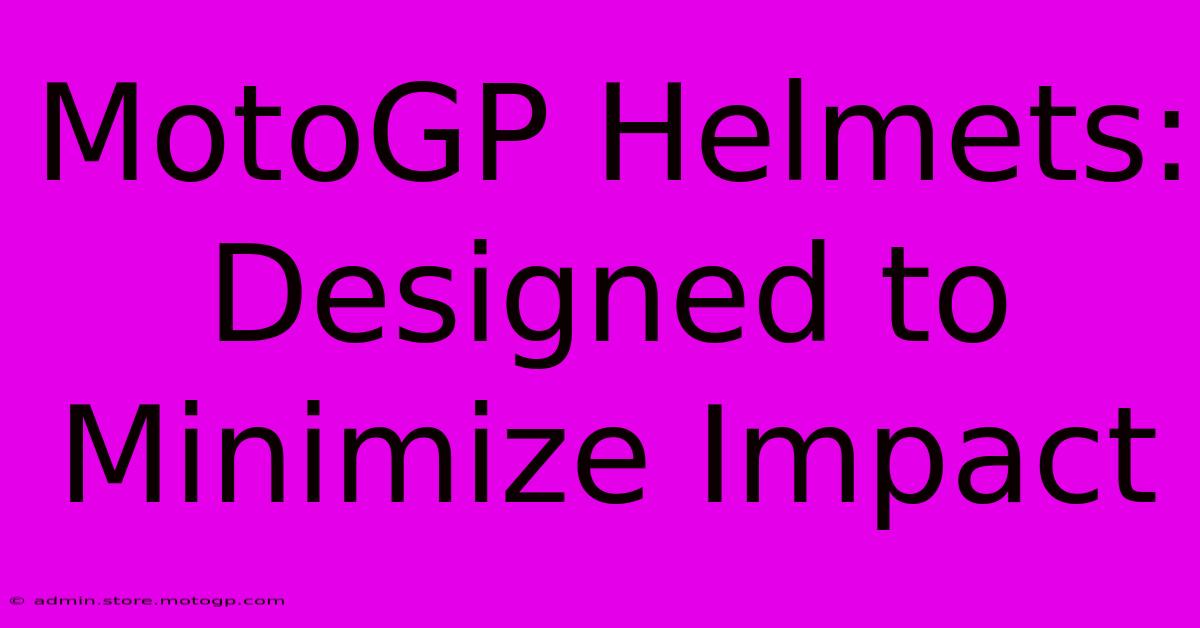MotoGP Helmets: Designed To Minimize Impact

Table of Contents
MotoGP Helmets: Designed to Minimize Impact
MotoGP racing, a spectacle of speed and precision, demands the utmost in rider safety. Central to this safety is the helmet, a crucial piece of equipment meticulously engineered to minimize the impact of crashes at terrifying speeds. This article delves into the advanced design and technology behind MotoGP helmets, exploring the features that protect riders from potentially catastrophic injuries.
The Importance of Helmet Technology in MotoGP
The forces involved in a MotoGP crash are immense. Riders routinely experience high-speed impacts, potentially leading to severe head injuries like concussions, skull fractures, and even fatalities. The helmet, therefore, is not merely a piece of protective gear; it's a sophisticated piece of engineering designed to absorb and disperse these forces, dramatically reducing the risk of injury.
Beyond the Shell: Key Features of a MotoGP Helmet
A MotoGP helmet isn't just a hard shell. It's a complex system comprising several key components working in synergy to provide maximum protection:
-
Multi-Composite Shell: Forget single-material shells. Top-tier MotoGP helmets utilize a multi-composite shell construction, often combining carbon fiber, aramid fiber (like Kevlar), and other advanced materials. This blend maximizes strength while keeping weight to a minimum – crucial for rider comfort and agility.
-
Multiple Density EPS Liner: The Expanded Polystyrene (EPS) liner is the helmet's shock-absorbing core. MotoGP helmets employ multiple densities of EPS, strategically placed to manage different types of impact. A denser EPS in areas prone to high-impact absorbs greater forces, while less dense EPS in other zones ensures comfort and ventilation.
-
Advanced Aerodynamics: The helmet's shape isn't just about looks. Aerodynamics play a vital role in stability at high speeds and minimizing buffeting. Sophisticated wind tunnel testing ensures the helmet's design reduces aerodynamic drag and enhances rider comfort.
-
Emergency Release System: Time is critical in a crash. Many MotoGP helmets incorporate emergency release systems, allowing medical personnel to quickly remove the helmet without causing further injury to a potentially unconscious rider. This often involves cheek pad release mechanisms.
-
Visor and Peak Protection: The visor is crucial for protection from debris and elements. MotoGP visors are typically made from highly resistant materials, often with anti-fog and anti-scratch coatings. The peak, or sun visor, helps manage glare and further protects the face.
Testing and Certification: Ensuring Helmet Integrity
MotoGP helmets undergo rigorous testing and certification to ensure they meet the stringent safety requirements of the sport. These tests involve simulating high-impact scenarios, assessing energy absorption, and evaluating the helmet's structural integrity under extreme conditions. Organizations like Snell Memorial Foundation and FIM (Fédération Internationale de Motocyclisme) set strict standards that manufacturers must adhere to.
The Ongoing Evolution of MotoGP Helmet Technology
The quest for enhanced safety is an ongoing process. Researchers and manufacturers continually strive to improve helmet design and materials, incorporating the latest technological advancements. Innovations like improved liner designs, lighter and stronger materials, and enhanced impact absorption technologies are constantly being developed and integrated into MotoGP helmets.
Conclusion: A Vital Shield for Extreme Speeds
MotoGP helmets represent the pinnacle of protective headgear technology. Their sophisticated design, advanced materials, and rigorous testing protocols are vital for protecting riders from the extreme forces experienced during racing. The ongoing commitment to innovation ensures that these helmets remain a crucial element in minimizing the risks associated with this demanding and exhilarating sport. As technology progresses, we can expect even greater advancements in helmet safety, further pushing the boundaries of rider protection.

Thank you for visiting our website wich cover about MotoGP Helmets: Designed To Minimize Impact. We hope the information provided has been useful to you. Feel free to contact us if you have any questions or need further assistance. See you next time and dont miss to bookmark.
Featured Posts
-
Park Closer To The Thrills Cota Parking Pass
Feb 20, 2025
-
The Fastest Way To The Grand Prix F1 Shuttle
Feb 20, 2025
-
Elevate Your Racing Bikes For Sale
Feb 20, 2025
-
The Queen Circuit An Unforgettable Journey
Feb 20, 2025
-
Unrivaled Performance Moto Gp Awaits
Feb 20, 2025
